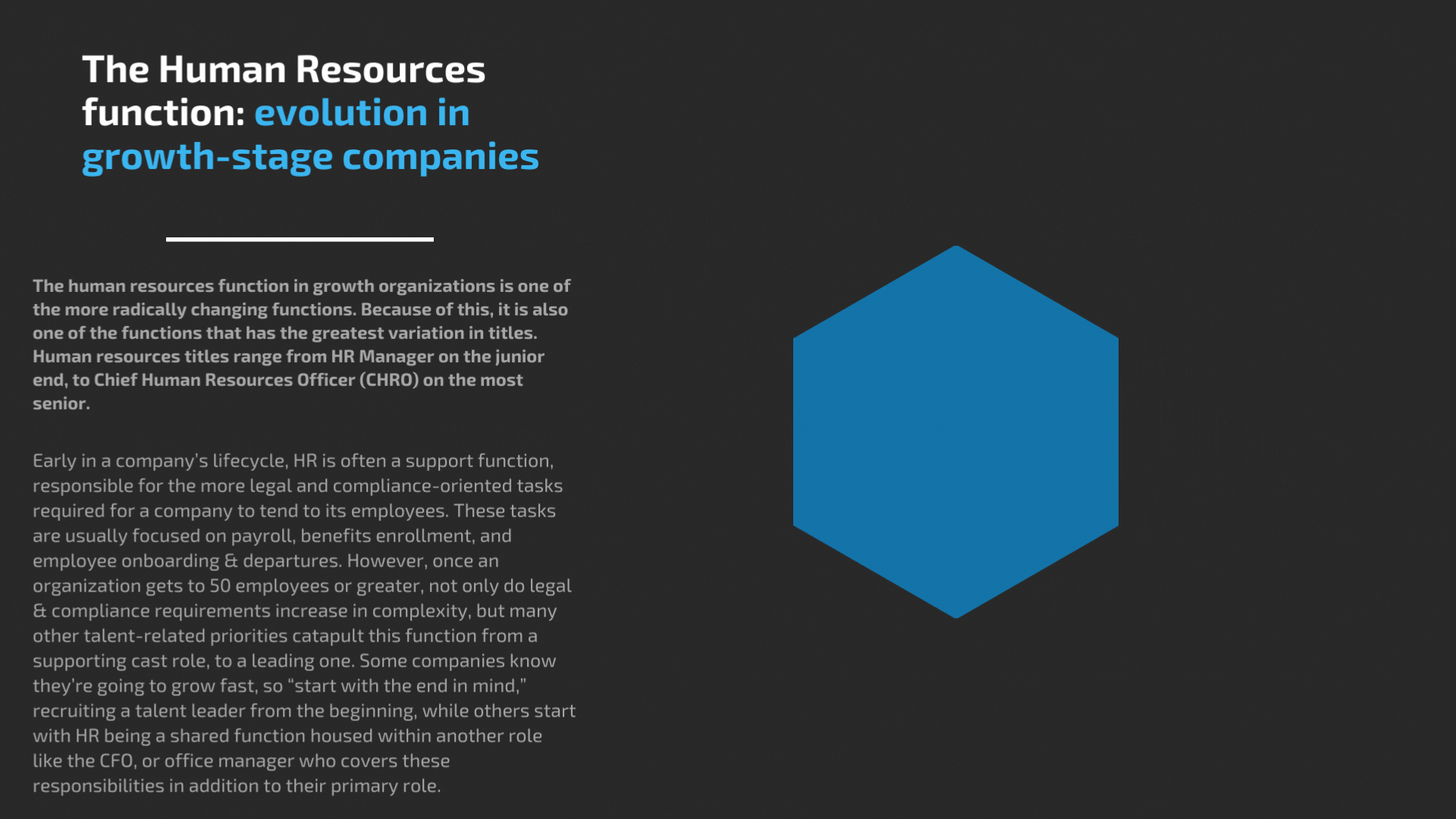The Evolution of the HR Function
HR & THE CHRO [CHIEF HUMAN RESOURCES OFFICER]

What are the organizational implications as a company grows?
SUMMARY
There are three key changes to the organizational structure as a business grows:
- Leadership layering: With the growth in headcount, more managers are required. This is often called layering.
- Functional specialization & splitting: Single function focus: With the growth in size, what had been a few leaders who played multiple simultaneous roles, gradually becomes more leaders with “single function focus.” This creates a spinning out of those roles no longer able to be performed by a single leader as they select and specialize in the one function that is their zone of excellence or genius.
- New Function creation: With the expansion of the business, new functions are born that hadn’t been needed in earlier stages of company growth.
Evolutionary changes within core functions in the company org chart. An organization can be parsed into 3 “meta-functions”-- MAKERS: those who make the product (manufacturing, operations, software development, engineering, services delivery, etc.); SELLERS: those who sell it; and “MEASURERS: those who set and measure progress and organizational health (e.g. finance, human resources, COO, President, CEO)
Human Resources & The Head of People
The human resources function in growth organizations is one of the more radically changing functions. Because of this, it is also one of the functions that has the greatest variation in titles. Human resources titles range from HR Manager on the junior end, to Chief Human Resources Officer (CHRO) on the most senior. Other titles that are often used include Chief People Officer, Head of Talent, VP People, Head of Talent & Culture, and more.
Early in a company’s lifecycle, HR is often a support function, responsible for the more legal and compliance-oriented tasks required for a company to tend to its employees. These tasks are usually focused on payroll, benefits enrollment, and employee onboarding & departures. However, once an organization gets to 50 employees or greater, not only do legal & compliance requirements increase in complexity, but many other talent-related priorities catapult this function from a supporting cast role, to a leading one. Some companies know they’re going to grow fast, so “start with the end in mind,” recruiting a talent leader from the beginning, while others start with HR being a shared function housed within another role like the CFO, or office manager who covers these responsibilities in addition to their primary role.
Whether a growth-oriented company hires a more junior HR resource in a support role at the beginning and either grows their capabilities as the organization grows, or hires above a more senior HR leader, ultimately, a company runs on people. And therefore, the HR talent function will inevitably increase with complexity and importance. Accordingly, there are many HR functional models that specify anywhere between 6 and 11 or more sub-categories that make up the human resources responsibility. For our purposes in growth-oriented businesses, we’ve identified 7 key HR sub-specialties
- Talent Management is the HR subfunction that is one of the broadest in the HR area. It includes everything to do with maintaining the health & wellbeing of existing employees, staffers and associates. This area is often responsible for functional and leadership succession planning. Employee relations is a core plank of the talent management subfunction, along with workforce planning that covers employee resignations, retirement, firing, lay-offs, sickness or death.
- Talent Acquisition, sometimes referred to as recruitment & selection, is a natural evolution within the human resources function as a function of a company’s success & ensuing expansion. This includes employee recruitment & onboarding programming, which dovetails with learning & development on the back-end of the onboarding period for new employees
- Expertise in Compensation & Benefits is critical at any company size, and becomes essential for recruiting & retention as the organization grows. Of rising importance within this HR subfunction includes compensation benchmarking across a given industry, compensation surveys, and the creation of compensation bands that are associated with various levels of increasing responsibility and seniority within the organization. Also of importance is the growth in importance of long-term incentive structuring, whether in cash or equity equivalents (e.g. LTIP as acronym for “long term incentive programs” usually created for more senior levels within a growing organization. For more on LTIPs, see the Appendix on deferred compensation programs & structures).
- Learning & Development (L&D) is critical to enabling employees not just career pathing for employee growth and retention, but the organization’s ability to “promote from within.” Company culture and alignment is also an area that learning & development can impact. Finally, L&D can also create programmatic learning modules that range from leadership development, to employee education for diversity-equity-inclusion-belonging initiatives, safety, sexual harassment prevention programming, and more.
- Performance Management grows in importance to ensure team members are given clear direction on “what” needs to be done, by “when,” and “how”—or within what guardrails must they remain in the pursuit of company targets & goals. Also, quarterly & annual reviews, employee stack-ranking if part of employer’s talent management framework, criteria & structure for minimally viable skills & experience for promotions to more senior responsibility, and performance improvement planning for those who are under-performers in the organization. Coaching can also be another responsibility of the performance management HR subfunction for all employee levels.
- Workplace Safety and HR Compliance grows in HR time committed as the business grows. This area includes key legal requirements like Fair Labor Standards Act (FLSA), Family Medical Leave Act (FMLA), Title VII, the National Labor Relations Act, and a host of other laws & regulations that increase in complexity both at the federal and state levels as the size of the company increases.
- Finally, Human Resources Information Systems (HRIS) & HR data & analytics has emerged in the last decade as another critical sub-system required to support a healthy company as it grows its people function. Far from the originsaal time clocks and vacation tracking software, these systems now increase the efficiency, impact and effectiveness of all human resources responsibilities. HRIS software is tailored to the needs of employee tracking and information dissemination, employee engagement surveys, learning & development content delivery & tracking, as well as key areas of compliance.

